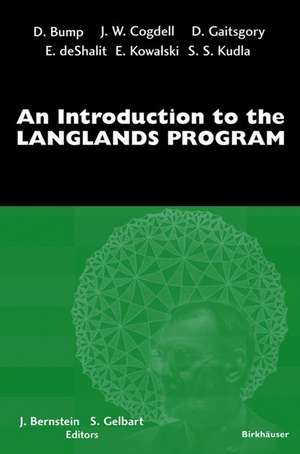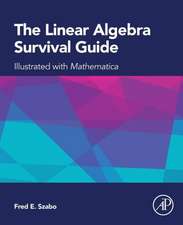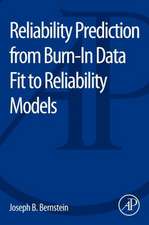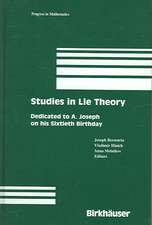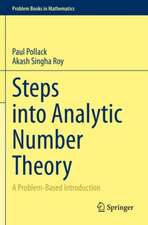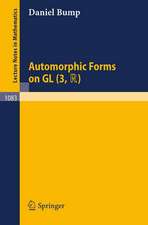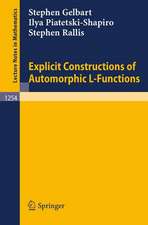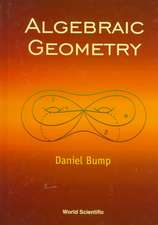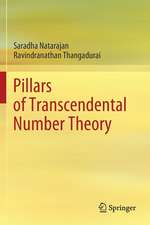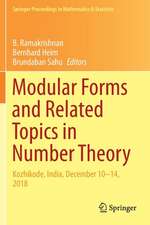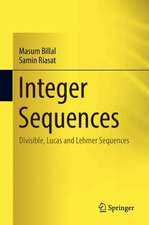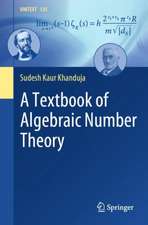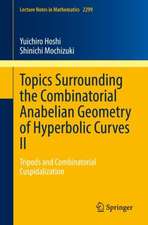An Introduction to the Langlands Program
Editat de Joseph Bernstein Contribuţii de S.S. Kudla Editat de Stephen Gelbart Contribuţii de E. Kowalski, E. de Shalit, D. Gaitsgory, J.W. Cogdell, D. Bumpen Limba Engleză Paperback – 20 mai 2003
Covered are a variety of areas in number theory from the classical zeta function up to the Langlands program. The exposition is sytematic, with each chapter focusing on a particular topic devoted to special cases of the program, and accessible to graduate students and researchers in the field.
Preț: 471.53 lei
Preț vechi: 554.75 lei
-15% Nou
Puncte Express: 707
Preț estimativ în valută:
90.25€ • 93.85$ • 75.52£
90.25€ • 93.85$ • 75.52£
Carte tipărită la comandă
Livrare economică 15-29 martie
Preluare comenzi: 021 569.72.76
Specificații
ISBN-13: 9780817632113
ISBN-10: 0817632115
Pagini: 281
Ilustrații: IX, 281 p.
Dimensiuni: 155 x 235 x 14 mm
Greutate: 0.43 kg
Ediția:2004
Editura: Birkhäuser Boston
Colecția Birkhäuser
Locul publicării:Boston, MA, United States
ISBN-10: 0817632115
Pagini: 281
Ilustrații: IX, 281 p.
Dimensiuni: 155 x 235 x 14 mm
Greutate: 0.43 kg
Ediția:2004
Editura: Birkhäuser Boston
Colecția Birkhäuser
Locul publicării:Boston, MA, United States
Public țintă
ResearchCuprins
Preface.- E. Kowalski - Elementary Theory of L-Functions I.- E. Kowalski - Elementary Theory of L-Functions II.- E. Kowalski - Classical Automorphic Forms.- E. DeShalit - Artin L-Functions.- E. DeShalit - L-Functions of Elliptic Curves and Modular Forms.- S. Kudla - Tate's Thesis.- S. Kudla - From Modular Forms to Automorphic Representations.- D. Bump - Spectral Theory and the Trace Formula.- J. Cogdell - Analytic Theory of L-Functions for GLn.- J. Cogdell - Langlands Conjectures for GLn.- J. Cogdell - Dual Groups and Langlands Functoriality.- D. Gaitsgory - Informal Introduction to Geometric Langlands.
Recenzii
From the reviews:
"The six chapters of this monograph give a broad, user-friendly introduction to the Langlands program, that is, the theory of automorphic forms and its connection with the theory of L-functions and other fields of mathematics. First-year graduate students and researchers will benefit from this beautiful text."
--Zentralblatt Math
". . . the present volume constitutes the most readable entree into the subject to date, suitable both for serious reading and for browsing, and should attract a new generation to this exciting subject. . . . Recommended."
--CHOICE
“I suspect this book will find its way into the hands of many graduate students. Perhaps it will also motivate a few of them to learn more, get involved, and make their own contributions.” (MAA REVIEWS)
"The six chapters of this monograph give a broad, user-friendly introduction to the Langlands program, that is, the theory of automorphic forms and its connection with the theory of L-functions and other fields of mathematics. First-year graduate students and researchers will benefit from this beautiful text."
--Zentralblatt Math
". . . the present volume constitutes the most readable entree into the subject to date, suitable both for serious reading and for browsing, and should attract a new generation to this exciting subject. . . . Recommended."
--CHOICE
“I suspect this book will find its way into the hands of many graduate students. Perhaps it will also motivate a few of them to learn more, get involved, and make their own contributions.” (MAA REVIEWS)
Textul de pe ultima copertă
For the past several decades the theory of automorphic forms has become a major focal point of development in number theory and algebraic geometry, with applications in many diverse areas, including combinatorics and mathematical physics.
The twelve chapters of this monograph present a broad, user-friendly introduction to the Langlands program, that is, the theory of automorphic forms and its connection with the theory of L-functions and other fields of mathematics.
Key features of this self-contained presentation:
A variety of areas in number theory from the classical zeta function up to the Langlands program are covered.
The exposition is systematic, with each chapter focusing on a particular topic devoted to special cases of the program:
• Basic zeta function of Riemann and its generalizations to Dirichlet and Hecke L-functions, class field theory and some topics on classical automorphic functions (E. Kowalski)
• A study of the conjectures of Artin and Shimura–Taniyama–Weil (E. de Shalit)
• An examination of classical modular (automorphic) L-functions as GL(2) functions, bringing into play the theory of representations (S.S. Kudla)
• Selberg's theory of the trace formula, which is a way to study automorphic representations (D. Bump)
• Discussion of cuspidal automorphic representations of GL(2,(A)) leads to Langlands theory for GL(n) and the importance of the Langlands dual group (J.W. Cogdell)
• An introduction to the geometric Langlands program, a new and active area of research that permits using powerful methods of algebraic geometry to construct automorphic sheaves (D. Gaitsgory)
Graduate students and researchers will benefit from this beautifultext.
The twelve chapters of this monograph present a broad, user-friendly introduction to the Langlands program, that is, the theory of automorphic forms and its connection with the theory of L-functions and other fields of mathematics.
Key features of this self-contained presentation:
A variety of areas in number theory from the classical zeta function up to the Langlands program are covered.
The exposition is systematic, with each chapter focusing on a particular topic devoted to special cases of the program:
• Basic zeta function of Riemann and its generalizations to Dirichlet and Hecke L-functions, class field theory and some topics on classical automorphic functions (E. Kowalski)
• A study of the conjectures of Artin and Shimura–Taniyama–Weil (E. de Shalit)
• An examination of classical modular (automorphic) L-functions as GL(2) functions, bringing into play the theory of representations (S.S. Kudla)
• Selberg's theory of the trace formula, which is a way to study automorphic representations (D. Bump)
• Discussion of cuspidal automorphic representations of GL(2,(A)) leads to Langlands theory for GL(n) and the importance of the Langlands dual group (J.W. Cogdell)
• An introduction to the geometric Langlands program, a new and active area of research that permits using powerful methods of algebraic geometry to construct automorphic sheaves (D. Gaitsgory)
Graduate students and researchers will benefit from this beautifultext.
Caracteristici
Self-contained presentation A variety of areas in number theory from the classical zeta function up to the Langlands program are covered Exposition is systematic, with each chapter focusing on a particular topic devoted to special cases of the program
